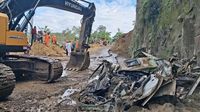On the evening of October 7, 2025, tragedy struck the rolling hills of Himachal Pradesh, India, when a massive landslide buried a passenger bus near the village of Balughat in the Bilaspur district. What began as a routine journey along the Marotan–Ghumarwin route ended in heartbreak, as the bus, carrying around 20 to 25 passengers, was engulfed by a torrent of mud and debris following days of relentless rain.
According to The Tribune, the bus—registration number HP69-5761—was struck by the landslide at approximately 6:40 pm. The force of nature proved devastating: by the next morning, the death toll had risen to 16, with the recovery of the body of Rahul, an eight-year-old boy who had been returning home with his mother and grandmother. The victims included nine men, four women, and three children. The only glimmers of hope in the disaster were the miraculous survival of two children, Shaurya and Arushi, who were rescued with minor injuries and discharged from AIIMS, Bilaspur, after receiving treatment.
Rescue operations were swift and intense. Sandeep Dhawal, Superintendent of Police, personally oversaw the efforts, which involved police, Home Guard personnel, and a National Disaster Response Force (NDRF) team. Local residents did not hesitate to jump into action, and their quick response helped save the two young survivors. By the afternoon of October 8, however, the grim work of searching for more victims was suspended, as all bodies had been recovered and handed over to families following post-mortem examinations at the Community Health Centre in Barthin.
The accident has shaken the local community and prompted a wave of condolences and promises of support from officials at every level. Chief Minister Sukhvinder Singh Sukhu expressed deep sorrow over the incident and conveyed his condolences to the affected families, while also ordering a judicial inquiry into the mishap. According to The Tribune, Rajesh Dharmani, the state’s Technical Education Minister, emphasized that although the landslide was a natural calamity, the government would investigate every aspect, especially since locals had previously reported the vulnerability of the accident spot to Public Works Department (PWD) officials.
Jai Ram Thakur, Leader of the Opposition, visited the Barthin health center to offer his sympathies and called for a serious review of such disasters. He remarked, "Himachal had suffered a lot due to natural disasters and this incident was very unfortunate. The government should look into such incidents seriously so that they do not occur due to human negligence." His words echoed the growing frustration among residents who feel their warnings about dangerous stretches of road are too often ignored.
Immediate relief was provided to grieving families. The district administration announced that each bereaved family would receive Rs 25,000 in emergency aid, with an additional Rs 4 lakh to follow under relief guidelines. Prime Minister Narendra Modi also stepped in, announcing Rs 2 lakh compensation for families of the deceased and Rs 50,000 for the injured. Indian President Droupadi Murmu and Prime Minister Modi both expressed their condolences and pledged ongoing government support for relief efforts, according to The Tribune and other national outlets.
The landslide in Bilaspur was not an isolated event. As reported by BBC and other international sources, extreme rainfall has battered South Asia throughout 2025, triggering deadly floods and landslides in India and neighboring countries like Nepal, Pakistan, Bangladesh, Bhutan, Sri Lanka, Afghanistan, and the Maldives. In August, flash floods wiped out an entire village in Uttarakhand, India, and at least 44 people died in Nepal over one weekend due to mudslides and floods. Kathmandu, Nepal’s capital, saw parts of the city submerged and all domestic flights canceled as the monsoon’s fury peaked just days before the Himachal Pradesh disaster.
Experts warn that these events are no longer rare anomalies but part of a disturbing trend. The once-predictable South Asian monsoon, which typically brings rain from June to September and again from October to December, has grown erratic in recent years. According to climate scientists cited by The Tribune and BBC, human-driven climate change is intensifying the monsoon, leading to extreme bursts of rainfall followed by prolonged dry spells. This unpredictability undermines the ability of communities and authorities to prepare for disasters, leaving vulnerable populations at the mercy of the elements.
In Himachal Pradesh, the impact of these changes is being felt acutely. Intermittent heavy rains since Monday, October 6, had already left mountain slopes dangerously unstable, setting the stage for the catastrophic landslide. Locals, familiar with the terrain and its risks, had repeatedly flagged the area near Balughat as hazardous, but their warnings went unheeded. The judicial inquiry ordered by the state government aims to determine whether lapses in infrastructure maintenance or oversight contributed to the disaster, and whether more could have been done to prevent such loss of life.
The story of the Balughat landslide is, in many ways, a microcosm of the broader challenges facing South Asia as it grapples with the twin pressures of climate change and rapid development. Roads and settlements are expanding into once-remote hillsides, often without adequate assessment of geological risks. When the rains come—harder and more unpredictably than ever before—the consequences can be catastrophic.
As the region mourns the loss of 16 lives in Himachal Pradesh, the focus now turns to the lessons that can be learned. Will authorities heed the voices of local residents who know the land best? Can disaster preparedness and infrastructure resilience keep pace with the new climate reality? And, perhaps most urgently, will the mounting toll of natural disasters spur meaningful action on climate change, both locally and internationally?
For now, families in Bilaspur and beyond are left to pick up the pieces, supported by government relief and the solidarity of their communities. The tragedy has cast a harsh spotlight on the risks faced by those living in the shadow of the Himalayas, and on the urgent need for both immediate action and long-term solutions. As rescue teams pack up and inquiries begin, one thing is clear: the memories of October 7, 2025, will linger long after the debris is cleared.

